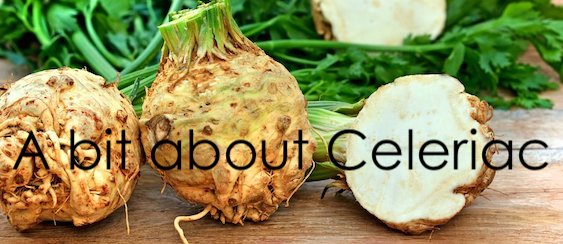Today’s post is about celeriac.
We recently tried this vegetable, prepared as chips. It was when we were eating them that I realised that we knew very little about this vegetable. So I have done some research and this is what I have learned.
What is celeriac?
It is a variety of celery, grown for its bulbous root. It is also known as celery root or knob celery. Historically popular in European and Mediterranean cuisine, the earliest documentation of this root vegetable dates back to the 1600s.
Both celeriac and celery belong to the same plant species: Apium graveolens. However, they do not come from the same crop because they require different types of growing conditions.
Celeriac partially grows underground and is harvested with a small tuft of leaves, which are still edible.
The root is pale and resembles a potato or turnip. Its mild flavour is similar to that of celery and parsley. Washed and peeled celeriac can be eaten raw or prepared using different cooking methods.
Does it have any health benefits?
Packed with fibre and vitamins B6, C and K. Celeriac is also a good source of antioxidants and important minerals, such as phosphorus, potassium and manganese.
It contains high levels of sodium, which aids in removing surplus water and acids from the body. As a result, consumption of this vegetable helps to reduce the stiffness of the skeletal muscles and relaxes the system.
Being high in vitamin K and phosphorus may help in bone metabolism and reducing the risk of osteoporosis. Vitamin K is especially important for bone health because it may help promote calcium absorption and inhibit bone deterioration.
Celeriac contains antioxidants, which are anti-inflammatory — they work by fighting against harmful free radicals, thus protecting healthy cells from damage.
Consuming foods that are high in vitamin C, such as celeriac, could help a person reduce their risk of high blood pressure by improving their ascorbic acid levels.
However, it’s important to note that boiling vegetables can reduce their vitamin C content by up to 50%. It’s unclear how cooking affects vitamin K. Using alternative cooking methods such as steaming — may prevent some vitamin loss.
How to eat it
Celeriac is often used as a healthier, lower-carb alternative to potatoes, with only 5.9 grams of carbs per 100 grams of cooked vegetable. As a raw vegetable, 100 grams contains only 42 calories and 0.3 grams of fat.
It is a multipurpose vegetable that can be prepared in various ways, both cooked and raw. When cooking, you can roast, boil, steam, grill, fry or sauté this vegetable.
It combines well with meats such as pork, lamb and duck and herbs like bay leaves and thyme. Popularly used in casseroles, stews and soups, but can also be mashed or baked. Mashed celeriac is best when mixed with other root vegetables like potato to create a smoother consistency.
Raw, it’s crunchy and has a nutty, mild celery-like flavour that makes it perfect for adding slices to salads or grated into coleslaws.
So next time you are wondering how to change up your dinner menu, why not try some celeriac.
Till the next post,
Live clean n prosper.
Sources – Mercola.com, Dept. of Health W. A., Healthline, Medical News Today, Wikipedia

